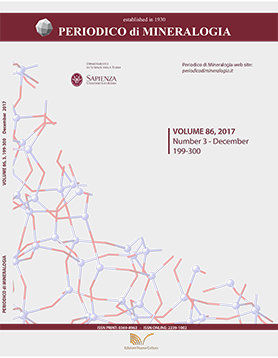The multi-fluid metasomatic genesis of the Archean Poona emerald deposit (Murchison Province, Western Australia): microtextures, geochemistry and oxygen isotope composition
DOI:
https://doi.org/10.2451/2017PM699Keywords:
Archean, blackwall, emerald, greenstone belt, metasomatism, oxygen isotopes, Poona, Western Australia, metapegmatite.Abstract
The Poona emerald deposit with the dormant Aga Khan mine is found in the Mt. Magnet-Meekatharra greenstone belt of the Murchison Province (Yilgarn Craton, Western Australia). The emerald/beryl, topaz, chrysoberyl, alexandrite, corundum, sapphire, ruby, fluorite and barite deposit of Poona is hosted in a tectonic melange of amphibolites, phlogopite schists (blackwall rocks), margarite schist and intensely deformed pegmatite veins. The mineralisation was produced by metasomatic reactions driven by fluids generated by metamorphic dehydration in the country rocks and their local interaction with amphibolites/greenstone rocks showing up to 2850 ppm Cr and pegmatitic dykes with a Be content up to 163 ppm. Fluid circulation and metasomatic reactions have been favoured by pervasive synmetamorphic deformation at amphibolite facies temperature of about 550 °C that is recorded in the stable oxygen isotope fractionation of quartz-beryl/emerald, quartz-garnet, quartz-biotite mineral pairs, mineral parageneses in the county rocks and Ti in quartz thermometry. The Archean EPMA U-Th-Pb monazite age of about 2636 Ma makes the Poona emerald mineralisation the oldest of the until now described emerald mineralisation and puts the emerald mineralisation into the magmatic and metamorphic event that affected the Murchison province in the time span between 2700 and 2610 Ma. The emerald mineralisation is coeval with the shear-zone synorogenic gold mineralisation that makes the Murchison Province one of the most important gold mining areas of Australia.


